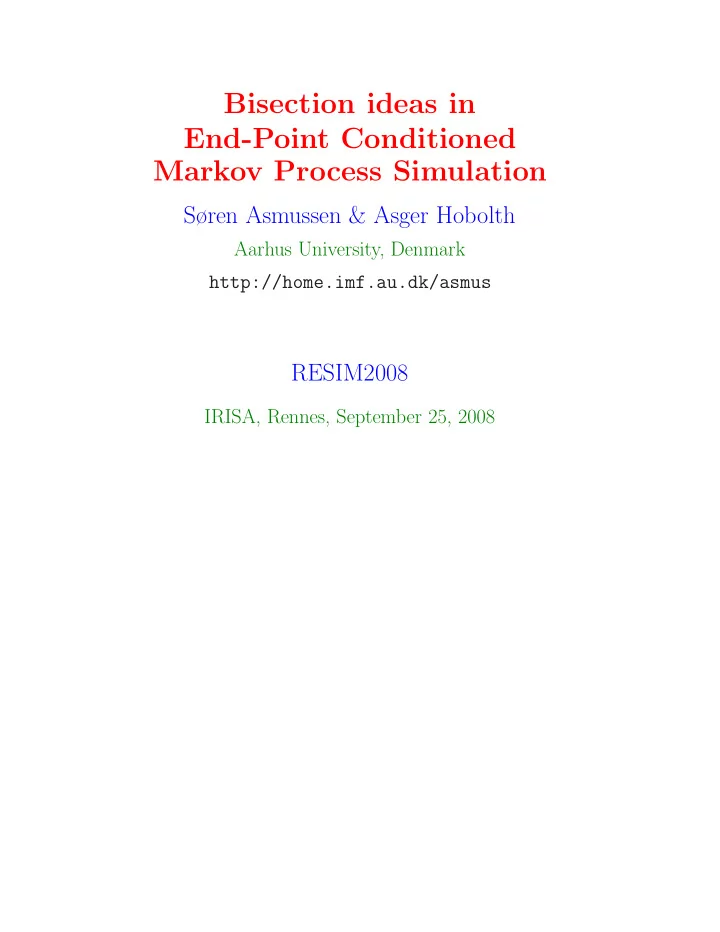

Bisection ideas in End-Point Conditioned Markov Process Simulation Søren Asmussen & Asger Hobolth Aarhus University, Denmark http://home.imf.au.dk/asmus RESIM2008 IRISA, Rennes, September 25, 2008
X finite Markov jump process on [0 , T ] Aim: simulate X conditioned on X (0) = a, X ( T ) = b Applications: statistical inference for Markov processes finance human genetics genomics
Aim: simulate X conditioned on X (0) = a, X ( T ) = b Naive algorithm: Start from X (0) = a First jump time exponential( q a ) new state a ′ chosen w.p. q aa ′ /q a ( q a = − q aa ) Repeat until T passed Reject path if X ( T ) � = b . Inefficient if P ab ( T ) small Otherwise hard to beat Other algorithms: Uniformization Direct simulation
Uniformization Unconditioned implementation: Choose λ > max i q i Simulate Poisson( λ ) process on [0 , T ] N ( T ) Poisson( λT ) Uniform epochs State changes at epochs according to p ij = q ij /λ Dummy transitions Conditioned implementation: P ( N ( T ) = n ) ∝ e − λT ( λT ) n p n ab n ! Uniform epochs State change at epoch k , state i according to p ij p n − k − 1 /p n − k jb ib Inefficient if q i variable Otherwise often good
Direct simulation (Hobolth, 2008) Start from X (0) = a First jump to a ′ with conditioned probability First jump time from f aa ′ b ( t ) (conditioned density) Repeat until T passed Messy formulas and r.v. generation Still often good Comparisons: Hobolth & Stone Ann. Appl. Statist. (2009)
Bisection for BM in [0 , 1] B (0) = 0 , B (1) ∼ N (0 , 1) B (1 / 2) from conditional normal given B (0) , B (1) B (1 / 4) given B (0) , B (1 / 2) B (3 / 4) given B (1 / 2) , B (1) Go on until desired resolution SA-Hobolth: Bisection algorithm for end-point conditioned CTMC (resolution not an issue)
Initialization, X (0) = X ( T ) = a No jumps w.p. e − q a T W.p. e − q a T /P aa ( T ), take X (0 : T ) ≡ a Otherwise at least two jumps, go on to recursion Initialization, X (0) = a � = b = X ( T ) One jump w.p. � T q a e − q a t q ab e − q b ( T − t ) d t R ab ( T ) = q a 0 W.p. R ab ( T ) /P ab ( T ), take X (0 : T ) with one jump. Jump time density prop. to integrand exponential V truncated to [0 , T ], jump time V or T − V Otherwise at least two jumps, go on to recursion
Recursion, a = b Know [0 , T ] has ≥ 2 jumps X ( T/ 2) =? e a = e − q a T/ 2 , r ab = R ab ( T/ 2) , p ab = P ab ( T/ 2) number of jumps number of jumps (unconditional) case in [0 , T/ 2] in [ T/ 2 , T ] probability not 1 0 0 e a e a 2 0 ≥ 2 e a ( p aa − e a ) 3 ≥ 2 0 ( p aa − e a ) e a 4 ≥ 2 ≥ 2 ( p aa − e a )( p aa − e a ) 5 1 1 r ac r ca α 6 1 ≥ 2 r ac ( p ca − r ca ) α 7 ≥ 2 1 ( p ac − r ac ) r ca α 8 ≥ 2 ≥ 2 ( p ac − r ac )( p ca − r ca ) α Sample among cases 2-8 Finish intervals with 0 or 1 Go on with ≥ 2 a � = b : very similar.
Figure 1:
Figure 2:
Figure 3:
Recommend
More recommend